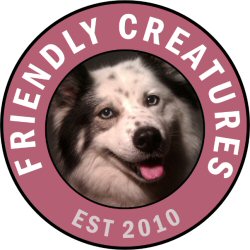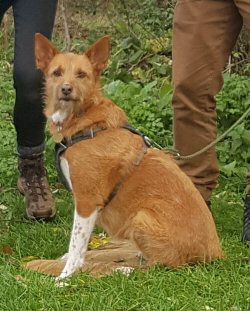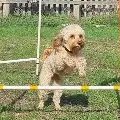| |
Surviving the terrible
teens...
 The
journey from puppyhood to adulthood is a fascinating and sometimes frustrating
phase in a dog's life. The period roughly between eight months and 18 months of
age is often referred to as adolescence. This stage can bring about a
host of behavioural changes that may surprise even experienced dog owners.
Understanding what is happening inside your dog's body and mind during this time
can help you navigate it with patience and consistency. Lydia of Friendly
Creatures Dog Club explains how to survive those times when your happy,
confident puppy turns into a teenager! The
journey from puppyhood to adulthood is a fascinating and sometimes frustrating
phase in a dog's life. The period roughly between eight months and 18 months of
age is often referred to as adolescence. This stage can bring about a
host of behavioural changes that may surprise even experienced dog owners.
Understanding what is happening inside your dog's body and mind during this time
can help you navigate it with patience and consistency. Lydia of Friendly
Creatures Dog Club explains how to survive those times when your happy,
confident puppy turns into a teenager!
Adolescence can be a whirlwind for dogs
and you, lovely agility people. Increased energy, testing boundaries, and
challenges with impulse control can leave both pup and owner feeling frustrated.
Changes in hormones and rapid growth spurts might make your dog forget what they
seemed to know yesterday, get easily distracted or lose confidence. Without
structured support, this stage can strain your relationship and stall progress.
The hormonal shift behind behavioural
changes
As adolescent dogs mature, their bodies undergo
significant hormonal changes. These hormones affect brain chemistry, behaviour,
and even emotional regulation.
-
Sex hormones such as testosterone (in
males) and oestrogen (in females) surge during adolescence, driving sexual
maturity.
-
These hormonal increases can heighten
risk-taking, impulsivity, and excitability, much like teenage humans.
-
Hormones can also temporarily interfere
with memory and learning, making trained behaviours seem to 'disappear' or
regress.
This is why an adolescent dog
may seem to 'forget' cues they once knew well or suddenly become distracted,
stubborn, or reactive.
 Common
unwanted behaviours during adolescence Common
unwanted behaviours during adolescence
For example, you
may notice a range of new or intensified behaviours during this stage.
-
Selective listening.
Ignoring known cues, especially when distracted or excited.
-
Increased independence,
wandering further on walks, less inclined to check in or recall promptly.
-
Boundary testing such as
jumping up, stealing items, chewing, or pushing limits they used to respect.
-
Fear and defensive
behaviour including barking, lunging, growling, nipping or even hiding
around other dogs or people.
-
Heightened energy and
restlessness especially if mental stimulation and enrichment needs aren't
met.
-
Resource guarding or
possessiveness occasionally emerging during hormonal shifts.
These behaviours are often
temporary, but they can be challenging if you are not prepared.
Why
training regression happens
Training regression during adolescence is common and not a sign of failure.
Because hormonal surges affect focus and impulse control, your dog's ability to
respond may temporarily decline. It's similar to a distracted teenager
struggling to focus on schoolwork while going through major changes.
How to support your adolescent
dog
-
Stay consistent. Keep
training sessions short, positive and frequent. Reinforce known commands and
celebrate small wins.
-
Manage the environment.
Prevent rehearsal of unwanted behaviours e.g. Use leads, baby gates or
crates when needed.
-
Increase mental
challenges and enrichment. Gentle physical exercises (like scentwork
games) and mental challenges help reduce frustration and restlessness.
-
Practise patience.
Remember, this is a passing phase. Don't punish forgetfulness' Instead,
guide and reward desired behaviours.
-
Socialise carefully.
Continue controlled exposure to people, dogs, and environments to build
confidence and good manners.
-
Consider professional
help, if needed. If behaviours feel overwhelming, a qualified dog trainer or
behaviourist can offer guidance.
 What
this means for agility training What
this means for agility training
-
Keep training sessions short. Ten minutes three times a week is
better than an hour's training session once a week
-
Avoid over-stimulation with long courses and fast speeds.
-
Keep hurdles low. This protects young dogs joints as well as
avoids the stress and excitement associated with high jumps
-
Scentwork. Mix up traditional agility with some slow Find It
games.
-
Time out. Have frequent breaks during the session.
-
Advocate for your dog. Explain to your club that you are going
slowly while they are showing adolescence behaviours
-
Solo sessions. Consider practising at home. You can make jumps
and weaves and have success even in a small area. Avoid the
heightened atmosphere of the club training class
-
Lower your expectations. You will be able to up the pressure
when your dog is more mature and can cope with competition.
The light at the end of the
tunnel
By around 18–24 months,
most dogs begin to settle into emotional and behavioural maturity. While the
adolescent phase can test your patience, it also offers an opportunity to
strengthen your bond and build resilience in your dog's training.
With understanding,
structure, and support, you and your dog can emerge from this stage as a
stronger team, ready to enjoy the calmer, confident adult dog they will soon
become.
 About
the author... About
the author...
Lydia, the founder of
Friendly Creatures, has owned and worked with animals since she was a teenager.
She trained her first dogs at aged 14 years old and worked with dogs and horses
during the summer holidays.
Despite being a Londoner, she has learned
to move sheep on and off Dartmoor the old-fashioned way on horseback using
Border Collies.
Over the years, Lydia has partnered her
dogs Louis and Bella in non-competitive and competitive agility, going to weekly
training sessions in Enfield and Barking and competing nationally. She noticed
that there was a lack of agility opportunities for ordinary pet dog owners who
live more centrally in London. Since becoming a dog trainer in East London, she
has set up popular dog agility taster sessions, six week courses as well as
flyball.
Lydia now lives in East Sussex with her
rescue LurcherAgility Dogs, a cat, two ponies, three goats and six hens. She says
understanding animal behaviour is her passion and is always learning something
new.
Friendly Creatures was established
in East London in 2010 by Lydia to promote knowledgeable owners and happy,
well-behaved dogs. As the number of dogs has increased so too has the club to
include an expert team of trainers running classes over numerous London venues
and online. Vanda joined Lydia as Business Partner in 2022.
Friendly Creatures is well-known and
popular with owners, providing high-quality and fun puppy training courses as
well as agility, flyball and excitables/reactive dog courses and lots more.
Trainershelp owners understand their dog's
behaviour and how they learn, so they can train them using force-free training
techniques and learn how to communicate better with each other. They also offer
1-2-1 training and behaviour sessions.
For more information, go to
https://friendly-creatures.co.uk
First published 14th September 2025
| |
|